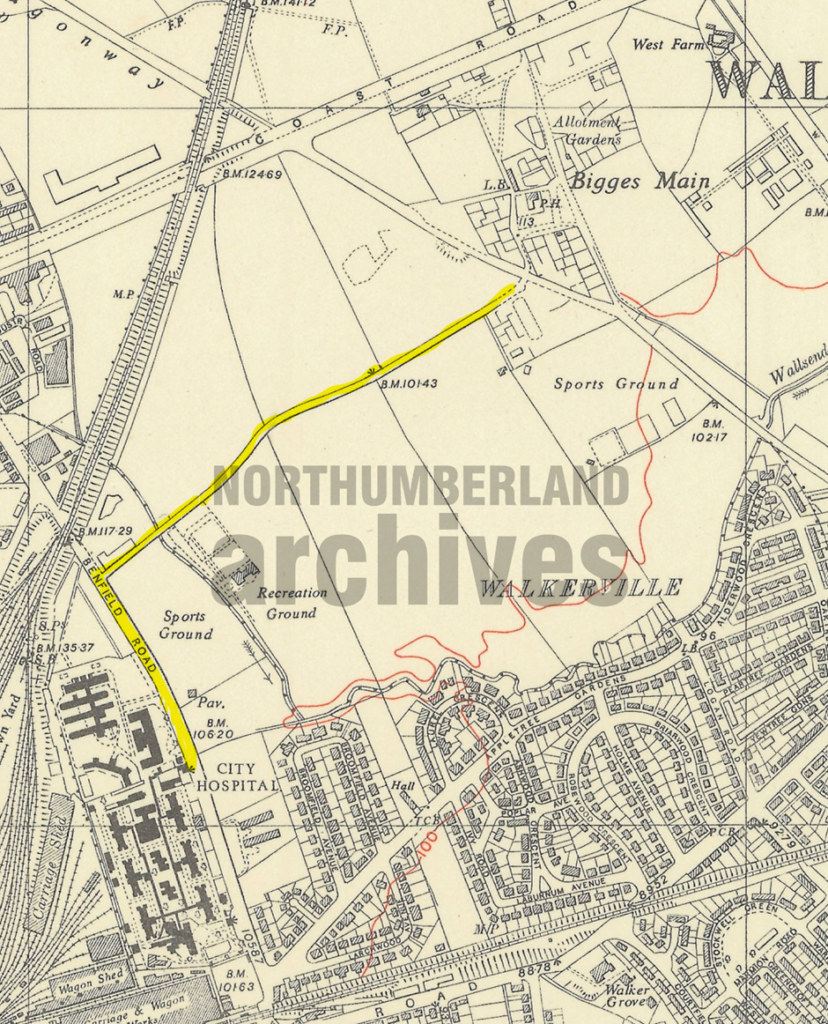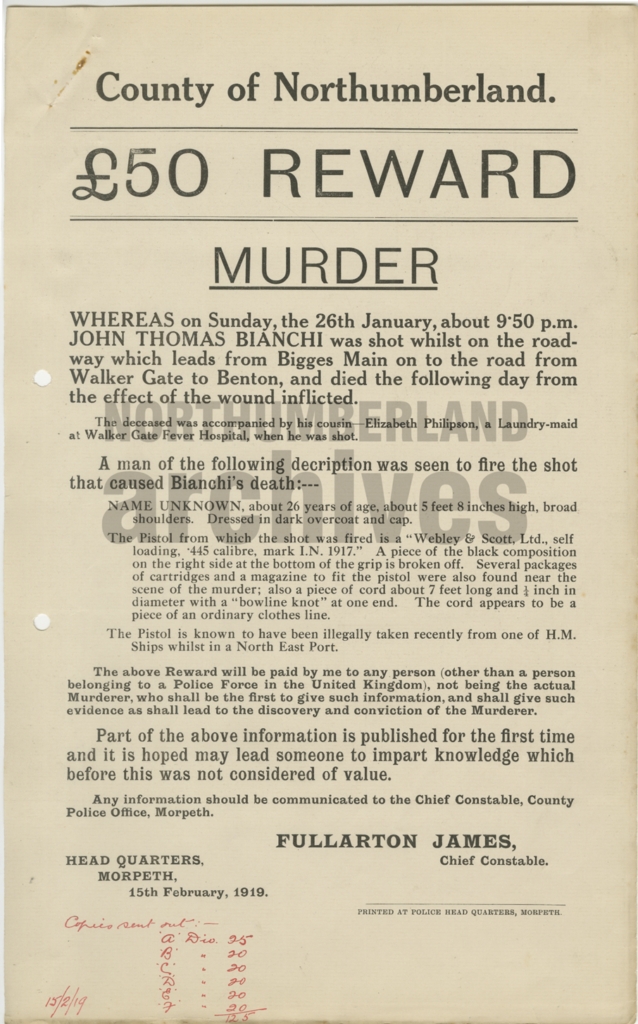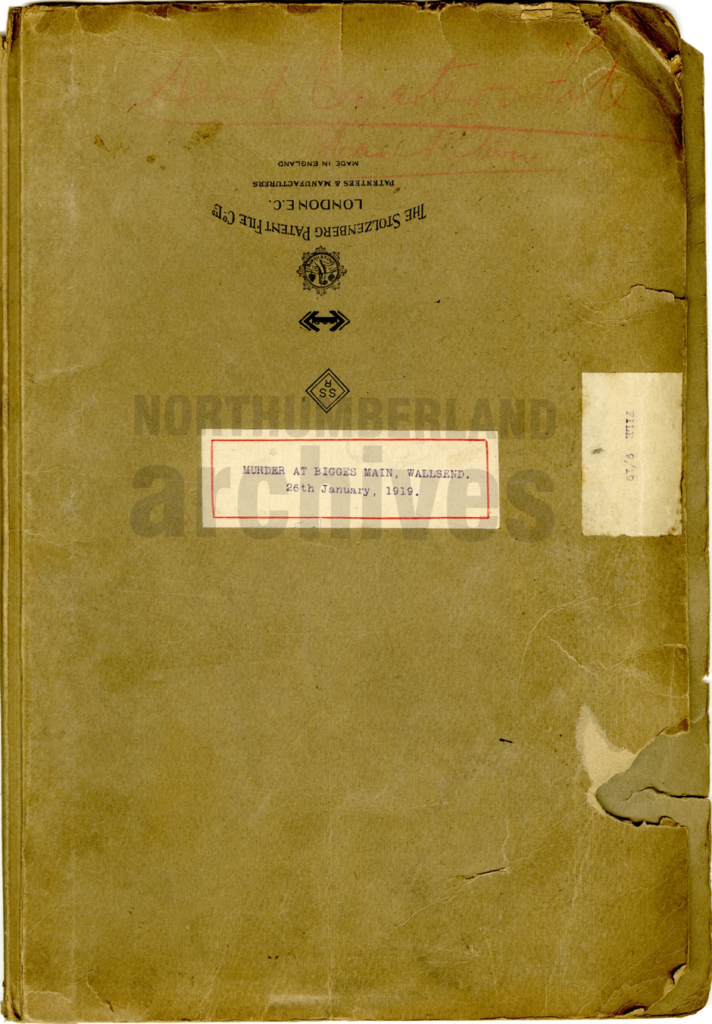Welcome back to our series of blogs on the murder at Bigges Main in 1919. Last time we looked at the theory of mistaken identity as a motive for the murder of John Thomas Bianchi and the assault on Elizabeth Phillipson. We also looked how the investigation moved to the E40 submarine.
This time, let us have a look at the route that John and Elizabeth were taking on the night of the shooting, and the route that the shooter took when fleeing the scene.
We know that John was escorting Elizabeth from his house in Chapel Row, Bigges Main to her place of work at Walkergate Hospital. The close-up image below is from the 1952 edition of Ordnance Survey maps and shows the highlighted route the pair would have taken. Setting out from Bigges Main village in a south westerly direction the lonnin bisects open fields towards the recreation ground. They would have been aiming for, what is now known as, and recorded on the map as Benfield Road (then called Benton Road). Just south of what local witnesses called the three arch bridge and onto the hospital on that road.

From Elizabeth’s statement she describes walking along the “Walker lonan” [1]…when about 200 yards along the road” she saw a man standing on the outside of the footpath and “when we were about two or three yards from him, he swung round and fired a shot.”
This information tells us that the shooter had only a very quick view of the pair and, bearing in mind that it was about a quarter to ten at night in January, and the lane was unlit, the view he would have got would have been very poor indeed. So, was he relying more on his hearing than his sight to identify his target? Or had he already observed them, perhaps further up the footpath? Or had he followed their routine on previous nights?
Elizabeth’s statement continues…
“I screamed and run round the man towards the Benton Road when he seized me by the shoulder, pulling me round, he then struck me in the corner of the left eye and I fell to the ground.”
Perhaps this description gives us a clue to the assailant, was he right-handed? If he held the gun in his right hand and went to hit Elizabeth, he would have naturally struck her in the left side of her face.
To hear how he made his escape let’s have a look at another piece of evidence and this time we are using a contemporary report in the newspaper. The Newcastle Daily Journal dated 29th January 1919 reports an interview with Elizabeth in which they claim she says,
“Dazed, I fell to the ground and feigned death. Next I heard a sound, as though he were jumping the fence, and, looking up found the man had crossed into the field.”
Elizabeth says she would know the man again by his back, as he was of a particularly solid build and positive his back would be unmistakable. The same publication claims to follow the route the murderer took from articles left behind, firstly the gun, then the newspaper claims that cartridges were found towards a reservoir and more still towards Walkergate hospital.
The same publication, two days later, interviews Charles Finlayson, the first person on the scene who helped carry John to his father’s cottage about 200 yards from where the shooting took place. Through Finlayson we hear some of John’s last words. John asked about the man who came from the direction of “Cartman’s” and returned the same way. The paper explains that “Cartman’s” is a cottage very near to the Benton Road end of the lane. Indeed, searching the 1921 census a family by the name of Cartman were still living at White Cottage, near Walker Gate, almost at the junction of the lonnin and Benton Road. Finlayson tells the Journal that the man is thought to have made off in the direction of Walkergate Hospital across a ploughed field.
Newcastle Daily Chronicle dated the of 20th February 1919 however reports from the inquest and quotes the deceased as saying the man had gone towards “Carville” is this a mis-hearing of Cartman’s? Or vice versa? Carville station was a railway station on the riverside loop of the Newcastle and North Shields railway. The loop ran between Byker and Willington Quay serving the heavy industry of the Tyne. From the scene of the murder escaping southeast over the fields you would naturally arrive at Wallsend Station on the main Newcastle to Tynemouth line before reaching the loop line and Carville station.
The staff of fourteen local inns or hotels were interviewed, conductresses on the Newcastle Corporation trams and the ticket collector at Walkergate Railway station were also interviewed but no one reported seeing any suspicious men that evening.
There are many witness statements in the file who did see a man in the “lonnin” around the time of the shooting, they describe the location in relation to the three-arch bridge. Rosy Cottage is mentioned by some, as pistol cartridges were found 50 yards north of Rosy Cottage stuffed into a hedge and others lying in the field adjacent to the hedge cache. One witness says she saw a man standing on the outside of the footpath just as Elizabeth said,
outside of the footpath just as Elizabeth said,
“opposite the little white gate leading into the old football field”.
She estimates the time of the shooting as about 9.45 pm, the same time as Elizabeth states.
Another witness saw a man at about 9:20pm midway between White Cottage (where the Cartmans lived) and Bigges Main and then claims to have seen the same man on the 8th of February pacing up and down outside the Colliery Engine Inn at Walkergate. The pub was at the junction of Shields Road and Benton Road/Benfield Road, just off the bottom left of the map above and very close to both the Walkergate hospital and the scene of the shooting. Unfortunately, the Colliery Engine Inn was not one of the pubs where staff were interviewed.
Another witness says that at about 8pm near the end of the gardens adjoining Cross Row, Bigges Main he passed a man who turned his face as the witness approached and the witness said that “I think I will know the man again” he was with another witness whose statement is very similar to his friends but added that the man had dark eyebrows. All the other witnesses have stated the man was wearing a cap so there has been no prior indication as to hair colour. Another clue then, we are perhaps looking for a man with dark eyebrows, and therefore perhaps dark hair?
Another witness says about 9:40pm she was walking with her “young man” from Walkergate to Bigges Main and saw a man opposite the football field and she says that he
“looked at us as if he wanted to see who we were.”
When they were at the end of Strawberry Terrace, Bigges Main she heard a shot, about two minutes after they had passed the man.
The gun was found 160 yards direct south of where the shooting took place according to PC James Sweeney’s statement, this perhaps shows the shooters direction of travel. PC Craghill states he found the gun and magazine cartridges partially concealed in a bush in a field. Possibly stashed to be collected at some time in the future?
So, we can see that there were a number of witnesses who saw a man on the lonnin just before the shooting some of who seemed to get a good clear look at him, but still the murderer could not be identified. So, the police tried another tactic. We have in the file the agenda item of the Standing Joint Committee meeting on the 3rd of February 1919 where it is agreed to issue a reward for information.
A poster was printed and issued as follows.
The Chief Constable of Durham County 150 copies, Newcastle City 50 copies, Gateshead Borough 30 copies, Tynemouth borough 20 copies, South Shields Borough 30 copies, Sunderland borough 30 copies, Hartlepool borough 20 copies, Middlesborough 30 copies and the River Tyne Police 10 copies.
One of those copies survives and is in the file, see the photo below.

Did this tactic work? Join us next time for our fourth and final blog in this series, where the identity of the killer is finally revealed.
Please note that the file about the murder and assault at Bigges Main is currently uncatalogued so is not yet available to the public in the Study Centre.
[1] A lonnin, according to Heslop’s glossary of words used in the County of Northumberland and on the Tyneside is “a lane, a narrow road”.








